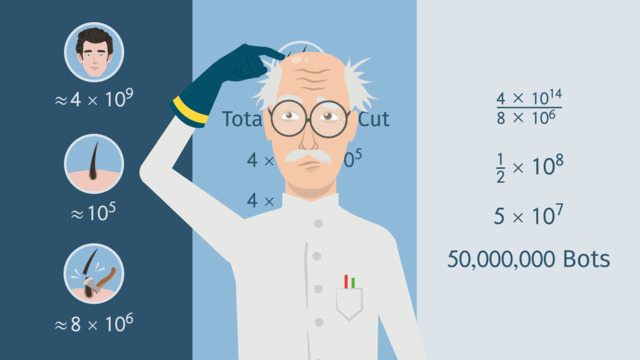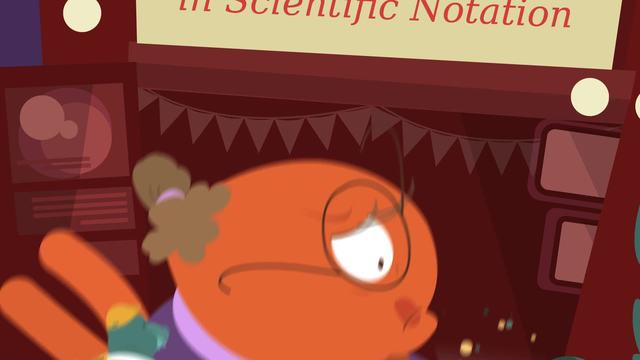Adding and Subtracting Numbers in Scientific Notation


Basics on the topic Adding and Subtracting Numbers in Scientific Notation
After this lesson, you will be able to use scientific notation to perform addition and subtraction with extremely large and extremely small numbers.
The lesson begins by teaching you the definition of scientific notation. It leads to converting numbers into scientific notation. It concludes with adding and subtracting numbers in scientific notation.
Learn how to add and subtract using scientific notation by helping the ants and the beetles figure out how to carry the weight of the pizza.
This video includes key concepts, notation, and vocabulary such as scientific notation (a method of writing or displaying numbers in terms of a decimal number between 1 and 10 and multiplied by a power of ten.)
Before watching this video, you should already be familiar with converting from standard to scientific notation, and using order of magnitude to compare numbers.
After watching this video, you will be prepared to learn how to define units by choosing a value in scientific notation and making that a unit.
Common Core Standard(s) in focus: 8.EE.4 A video intended for math students in the 8th grade Recommended for students who are 13 - 14 years old
Transcript Adding and Subtracting Numbers in Scientific Notation
Hidden in the grass, these ants have discovered lunch for the entire week! Hmmm, Hawaiian pizza, what luck! But wait, a couple of beetles claim they found it first. Whoever can lift it gets to eat it! The ants put their 30 legs into the effort, but this deep dish is too much! The beetles figure they can work it out, but no! The ants and the beetles come together to take the pizza down the long and winding road. In order to carry that weight, the ants and beetles will need to add and subtract numbers in scientific notation. The pizza slice weighs zero point two three one pounds. Notice that if we multiply zero point two three one by ten over ten and simplify, we get two point three one times 10 to the negative one. Rewriting a decimal in this way is known as scientific notation. It is a method of writing or displaying numbers in terms of a decimal number between 1 and 10 multiplied by a power of 10, and it is commonly used to write very small or very large numbers. Notice that the decimal in this example is moved ONE place to the RIGHT, giving us a negative power. In general, if you move the decimal to the left, the exponent INCREASES. And if you move the decimal to the right, the exponent DECREASES by the same amount. The ants only weigh a tiny fraction of a pound, but they can lift 50 times their own weight! Each ant weighs about point zero, zero, zero, zero, six, six, two pounds. To convert that to scientific notation, we move the decimal 5 places to the right because we want the leading number to be between 1 and 10. That gives us 6 point sixty-two times 10 to the negative five. Each ant can lift 50 times it's own weight. That ends up being three point three one times 10 to the negative three. Remember, there are five ants, so that means that all five ants together can lift one point six six times 10 to the negative two. Now, how about the beetles? The beetles weigh about point zero one one two pounds. In scientific notation, that is one point twelve times 10 to the negative two. And they can each lift 10 times their own weight. That ends up being one point twelve times 10 to the negative one. There are two beetles, so that's two point twenty-four times 10 to the negative one. How much can the ants and beetles lift altogether? We need to add these two numbers. How do we add two numbers in scientific notation? There are three steps. First, we make sure the two numbers feature the same power of 10. In this case, we'll need to modify one of the numbers to make that happen. Let's choose to change the 10 to the negative one to a 10 to the negative two by moving the decimal one place to the right. We get twenty-two point four times 10 to the negative two. For the next step, we factor out the 10 to the negative two. Finally, we add one point six six and 22 point four. That's about 24.1. In scientific notation, twenty-four point 1 times 10 to the negative two is two point four one times 10 to the negative one pounds. That's just a little bit more than the weight of the pizza! The ants and the beetles have a ticket to ride! Hmmm, the pizza looks so delicious that they can't resist eating some of it on the way. But how much pizza did the insects eat while snacking? Altogether, the ants eat point zero five nine seven pounds. In scientific notation, that's five point ninety-seven times 10 to the negative two. The beetles eat point one one three pounds each. That's one point one three times 10 to the negative one. Remember, to add numbers in scientific notation, we need the powers of 10 to be the same. Let's work with the second number, and move this decimal one place to the right. That means the exponent DECREASES by 1. Eleven point three times 10 to the negative two. Now we factor out the 10 to the negative two and add the decimal parts. Five point ninety-seven plus 11.3 is about 17.3. That's one point seventy-three times 10 to the negative 1st pounds in scientific notation. They ate a lot! How much pizza do they have left? The original weight of the pizza was two point three one times 10 to the negative one. And we just found that the amount of pizza they ate in total is one point seven three times ten to the negative one. To subtract two numbers in scientific notation, we follow the same steps as with addition. The powers of 10 are already the same! Factoring, we get two point three one minus one point seven three is point five eight, or five point eight times 10 to the negative two pounds. There's very little left--the ants and beetles should just let it be! Let's review. Adding or subtracting numbers in scientific notation takes three steps. First, we make sure the two numbers feature the same power of 10. Then, we factor out the power of 10. Finally, we add the decimal parts. You may want to put your final answer in scientific notation. Ok, ants and beetles, time to rock and roll! Uh oh, I guess the old saying is true. Happiness is a warm pizza... and a nap!
















